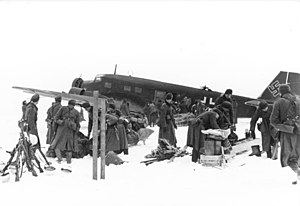
Back جيب ديميانسك Arabic Děmjanský kotel Czech Demjanskkedlen Danish Kesselschlacht von Demjansk German Bolsa de Demiansk Spanish محاصره دمیانسک Persian Demjanskin motti Finnish Poche de Demiansk French מבצע דמיאנסק HE Gyemjanszki katlancsaták Hungarian
This article includes a list of general references, but it lacks sufficient corresponding inline citations. (October 2008) |
| Demyansk Pocket | |||||||
|---|---|---|---|---|---|---|---|
| Part of the Eastern Front of World War II | |||||||
 | |||||||
| |||||||
| Belligerents | |||||||
|
|
| ||||||
| Commanders and leaders | |||||||
| Pavel Kurochkin | |||||||
| Units involved | |||||||
| 16th Army | Northwestern Front | ||||||
| Strength | |||||||
|
100,000 (initially)[2][3] 31,000[4] (reinforcements) | 400,000 (initially) | ||||||
| Casualties and losses | |||||||
|
9,000[5] KIA and MIA 46,000[6] WIA 265 aircraft destroyed Total: 55,000 |
88,908 killed & missing 156,603 wounded Total: 245,500[7] | ||||||
The Demyansk Pocket (German: Kessel von Demjansk; Russian: Демя́нский котёл) was the name given to the pocket of German troops encircled by the Red Army around Demyansk, south of Leningrad, during World War II's Eastern Front. The pocket existed mainly from 8 February to 21 April 1942.
A much smaller force was surrounded in the Kholm Pocket at the town of Kholm, about 100 km (62 mi) to the southwest. Both resulted from the German retreat after its defeat during the Battle of Moscow.
The successful defence of Demyansk was achieved by using an airbridge and was a significant development in modern warfare. Its success was a major contributor to the decision by the Army High Command to try the same tactic during the Battle of Stalingrad, but it then failed to save the 6th Army, commanded by Friedrich Paulus.
- ^ Glantz 2001, p. 31.
- ^ Hayward 1997, p. 24.
- ^ Beevor 1999, p. 43.
- ^ Nigel Askey, Operation Barbarossa: the Complete Organisational and Statistical Analysis, and Military Simulation, Volume IIA, 2013, p. 539
- ^ Nigel Askey, Volume IIA, 2013, p. 539
- ^ Nigel Askey, Volume IIA, 2013, p. 539
- ^ "Г.Ф.Кривошеев (под редакцией). Россия и СССР в войнах XX века: Потери вооруженных сил". Lib.ru. Retrieved 2017-06-23.